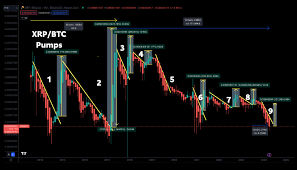It all started with a curious question that most crypto enthusiasts have at some point — why is Bitcoin always the talk of the town while XRP quietly keeps showing up in the background, holding on, never quite giving up? Imagine this: a young investor, scrolling through his crypto portfolio late at night, stares at the glowing numbers on the screen and wonders, “If I had bought Bitcoin in 2013, I’d be a millionaire now. But what if I put that same money into XRP?” This simple thought is where our story begins — a story that dives deep into how XRP price truly compares to Bitcoin’s, not just in numbers, but in purpose, technology, and the faith behind each coin.
The Origin and Purpose: Two Giants, Two Paths
Before we get tangled in charts and market graphs, we need to understand the very soul of these two cryptocurrencies. Bitcoin (BTC) was born in 2009 out of rebellion — a digital answer to the global financial crisis, designed to replace banks with decentralized trust. Its creator, Satoshi Nakamoto, envisioned a world where money moved freely without intermediaries. On the other hand, XRP (Ripple) entered the stage in 2012 with a different mission. It didn’t want to destroy the financial system; it wanted to fix it. Built by Ripple Labs, XRP was made to bridge banks, not bypass them — to make cross-border transactions faster, cheaper, and more efficient.
While Bitcoin thrives on decentralization, XRP thrives on integration. That’s the key difference that later shaped how their prices behaved. Bitcoin’s supply is capped at 21 million coins, giving it a natural scarcity that drives up its value over time. XRP, meanwhile, started with 100 billion tokens, most of which were distributed or held by Ripple Labs to control liquidity. This simple distinction is one of the main reasons why XRP’s price has always been lower compared to Bitcoin’s astronomical levels.
Market Value and Historical Performance: The Battle of Numbers
When we talk about price comparison, it’s impossible to ignore the historical dominance of Bitcoin. For years, Bitcoin has been the benchmark — the king of all cryptocurrencies, often referred to as digital gold. In December 2017, Bitcoin hit an all-time high of nearly $20,000, shocking the world. It later smashed that record in late 2021, reaching over $60,000, making early investors unimaginably wealthy. Meanwhile, XRP also had its moment in the sun. During the 2017 bull run, XRP soared from fractions of a cent to over $3.84, briefly becoming the second-largest cryptocurrency by market capitalization. However, regulatory issues, particularly the SEC lawsuit against Ripple, caused its value to plummet and stagnate for years.
Still, XRP refused to die. Despite facing immense legal pressure and market skepticism, it maintained a loyal community and real-world utility. While Bitcoin is seen more as a store of value, XRP is viewed as a transactional currency — used by banks and financial institutions to move money across borders in seconds. So even though XRP’s price may not rival Bitcoin’s, its function keeps it relevant in the modern financial landscape. The two play entirely different games: Bitcoin is the digital equivalent of gold bars, while XRP is the rail network moving money faster than traditional systems.
Technology and Speed: Power vs Precision
If you ever tried to send Bitcoin across the blockchain during high network congestion, you know how slow and costly it can get. Each Bitcoin transaction can take anywhere from 10 minutes to over an hour, depending on the network load. The transaction fee also varies, sometimes spiking up to tens of dollars. Now compare that with XRP, which processes transactions in about 3–5 seconds, at a cost of mere fractions of a cent. The RippleNet technology that powers XRP is not just fast — it’s efficient, scalable, and environmentally friendly. Where Bitcoin’s blockchain requires massive energy due to proof-of-work mining, XRP Ledger (XRPL) uses a consensus protocol, consuming minimal energy and achieving high throughput.
This contrast is massive, and it directly influences how investors perceive value. Bitcoin’s high price comes partly from its difficulty to mine and its perception as a digital asset of scarcity. Meanwhile, XRP’s low price is a reflection of its abundance and utility rather than rarity. Yet, as the world moves toward sustainability and speed, more eyes are turning toward eco-friendly cryptocurrencies like XRP. It may not hold the same glamour as Bitcoin, but it stands tall in innovation and functionality.
Market Sentiment and Regulation: The Hidden Forces Behind Price
The price of any cryptocurrency isn’t just numbers on a chart; it’s a reflection of emotion, trust, and belief. Bitcoin benefits from a strong emotional brand — it’s seen as rebellion, freedom, and wealth. It’s the first name that comes to mind when someone says “crypto.” Investors trust Bitcoin because it has stood the test of time. In contrast, XRP faced an uphill battle due to its connection with Ripple Labs and the SEC lawsuit, which accused Ripple of selling unregistered securities. This lawsuit dragged XRP through uncertainty for years, limiting its access on major exchanges and dampening investor confidence. However, after partial victories in court, the community regained faith, and XRP’s price started recovering.
Regulation plays a much bigger role in XRP’s price volatility than it does in Bitcoin’s. Bitcoin, being decentralized, cannot be easily targeted by regulators. But XRP, having a central company behind it, remains under more scrutiny. Still, it’s important to note that Ripple’s partnerships with global banks and institutions like Santander and Standard Chartered have given it a real-world credibility that few other cryptocurrencies enjoy. The more adoption XRP achieves in cross-border settlements, the more its long-term value could stabilize, potentially narrowing the gap with Bitcoin — though not in absolute price, but in utility-driven market importance.
Investment Perspective: Which One Should You Trust More?
Every investor dreams of catching the next big wave. But the choice between Bitcoin and XRP depends on what kind of investor you are. If you’re looking for long-term value storage — something like a digital vault — Bitcoin is your best friend. It’s volatile, yes, but it’s proven. On the other hand, if you’re more interested in a coin that’s actively used in the financial system, with faster growth potential and practical use cases, XRP might be more appealing. Its price is much lower, making it accessible to newcomers, while its potential for mass adoption keeps it exciting for seasoned traders.
The truth is, XRP’s price will likely never match Bitcoin’s, because their fundamentals are built differently. However, percentage gains are where XRP shines. Historically, during bull markets, XRP has shown explosive upward movements, giving traders remarkable short-term opportunities. Meanwhile, Bitcoin continues to be the steady giant that defines the entire market’s direction.
Future Outlook: The Road Ahead
The future of xrp price is not a war but a coexistence. Both have unique purposes, audiences, and roles in shaping the digital economy. As regulatory clarity improves, especially for XRP, we may see greater institutional adoption that could push its price beyond current expectations. Bitcoin, on the other hand, will continue to act as a store of value and a hedge against inflation, similar to gold in the traditional world. As the crypto ecosystem matures, both assets might not compete — they might complement each other. Banks might use XRP to transfer money, while investors hold Bitcoin as a long-term wealth protector.
The emotional energy behind both coins is undeniable. Bitcoin represents freedom and independence; XRP represents progress and speed. Both are powerful stories written in code — different philosophies bound by one blockchain future. In the end, whether you choose Bitcoin or XRP, you’re participating in the revolution of finance itself.

